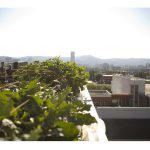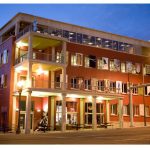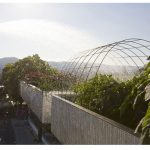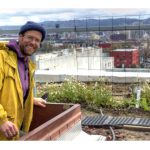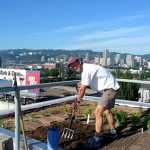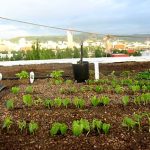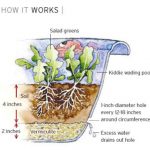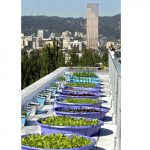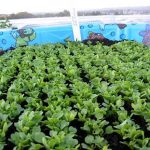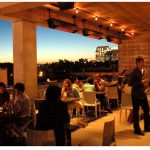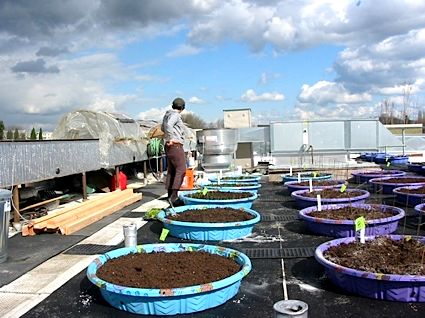
Additional Resources
Visit The Burnside Rocket website here. See: the Press Release of March 1, 2008 here, “Rooftop Vegetable Gardener at Rocket Rooftop Garden takes us on a tour!” by Marc Boucher-Colbert from 2008 in City Farmer here, “Portland’s New Wave of Educators: Three graduates are growing the seeds of sustainability through education” by Ivy Manning in Edible Portland, of Summer 2008 here, and “Rocket Science ? An edible rooftop garden in Portland” by Kym Pokorny in City Farmer News of October, 2007 here. For more info contact Kevin Cavenaugh at 503.335.0091, kevin@tenpod.org; Joshua Cohen at 503.349.2404, jcohen71@gmail.com; or Marc Boucher-Colbert at jambrazil2@yahoo.com.
The Burnside Rocket is a new mixed-use building located at the corner of East Burnside and NE 11th Avenue in Portland, Oregon. The site is a 3,800 sf (350 m2) former vacant lot, adjacent to an indoor rock climbing gym. The building includes 16,500 sf (1533 m2) of indoor area on four floors, plus outdoor terraces at each level. Construction was completed in April 2007, and the building is fully leased. The project team is projecting LEED Platinum certification, and the project was funded by a combination of equity, debt, and grants – see the Press Release below for more info. The Burnside Rocket includes: Chesterfield, art music and mixology by Leo Rivera; Nervo.tv, design and animation studio; Pacific Rim Winemakers, northwest windery obsessed with Riesling; TENpod, shared office for creative professionals; and Rocket, fine dining and cocktails by Leather Storrs.
Marc Boucher-Colbert, the rooftop vegetable gardener, says, “Currently we have available as growing space two ecoroof sections that were part of the building?s original ?green? design (about 150 sq. ft. total), six 3?x 9? raised beds that are 18? deep, and 39 45? diameter shallow ?kiddie? pools (12 square feet each)…From the start I used a coconut fiber-based potting blend (made by Black Gold) with spectacular results. We also amend almost every planting with a mix of some or all of the following: kelp meal, glacial rock dust, bone meal, blood, worm castings, or a balanced organic fertilizer (5-5-5, for you garden numerologists), and when necessary, we will water with a dilute organic fertilizer, such as a fish/kelp solution. Our soil depths vary from as little as 3? in our pools to 6?or so in our ecoroof sections to about 18? in our raised beds,” (City Farmer News, 2008)Marc continues, “Our goal for the garden is to grow food year-round which will provide the chefs with the prime material they need to exercise their creativity.” The chefs stipulated they grow chives, thyme, and parsley, and several types of arugulas and lettuces. Marc adds, “Beyond these staples, there are the seasonal changes. We grow mache and endive in the fall, winter and spring, and of course we have tomatoes, eggplant, peppers, summer squash, and cucumbers in the warmer months. Besides the usual garden grammar, there is the whimsical punctuation: a planting of fennel for small, grillable bulbs, some cress thrown in for kicks (literally), the hard-to-find golden-podded peas. Practically anything we grow can get worked into a special, and if any of these occasional items is beloved enough in the kitchen, it may work its way into permanent status. The challenge is and will remain how to leave enough room for the regular offerings while also keeping space available for trailing new crops and varieties.”
 Greenroofs.comConnecting the Planet + Living Architecture
Greenroofs.comConnecting the Planet + Living Architecture
